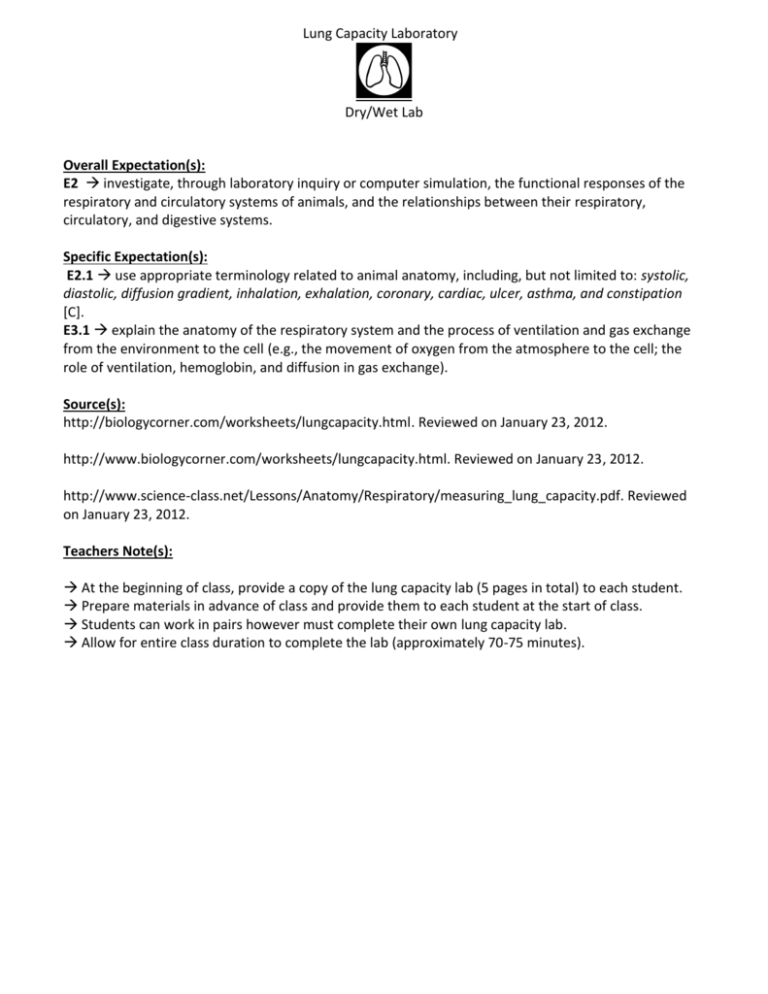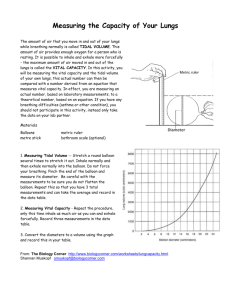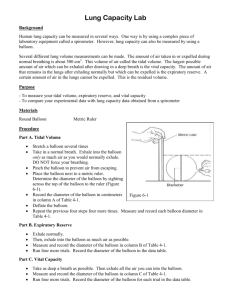Lung Capacity Lab
advertisement

Lung Capacity Laboratory Dry/Wet Lab Overall Expectation(s): E2 investigate, through laboratory inquiry or computer simulation, the functional responses of the respiratory and circulatory systems of animals, and the relationships between their respiratory, circulatory, and digestive systems. Specific Expectation(s): E2.1 use appropriate terminology related to animal anatomy, including, but not limited to: systolic, diastolic, diffusion gradient, inhalation, exhalation, coronary, cardiac, ulcer, asthma, and constipation [C]. E3.1 explain the anatomy of the respiratory system and the process of ventilation and gas exchange from the environment to the cell (e.g., the movement of oxygen from the atmosphere to the cell; the role of ventilation, hemoglobin, and diffusion in gas exchange). Source(s): http://biologycorner.com/worksheets/lungcapacity.html. Reviewed on January 23, 2012. http://www.biologycorner.com/worksheets/lungcapacity.html. Reviewed on January 23, 2012. http://www.science-class.net/Lessons/Anatomy/Respiratory/measuring_lung_capacity.pdf. Reviewed on January 23, 2012. Teachers Note(s): At the beginning of class, provide a copy of the lung capacity lab (5 pages in total) to each student. Prepare materials in advance of class and provide them to each student at the start of class. Students can work in pairs however must complete their own lung capacity lab. Allow for entire class duration to complete the lab (approximately 70-75 minutes). Lung Capacity Lab Background Human lung capacity can be measured in several ways. One way is by using a complex piece of laboratory equipment called a spirometer. However, lung capacity can also be measured by using a balloon. Several different lung volume measurements can be made. The amount of air taken in or expelled during normal breathing is about 500 cm3. This volume of air called the tidal volume. The largest possible amount of air which can be exhaled after drawing in a deep breath is the vital capacity. The amount of air that remains in the lungs after exhaling normally but which can be expelled is the expiratory reserve. A certain amount of air in the lungs cannot be expelled. This is the residual volume. Purpose - To measure your tidal volume, expiratory reserve, and vital capacity - To compare your experimental data with lung capacity data obtained from a spirometer - Examine data and begin to draw conclusions Materials Round Balloon Metric Ruler Procedure Part A. Tidal Volume Stretch a balloon several times Take in a normal breath. Exhale into the balloon only as much air as you would normally exhale. DO NOT force your breathing. Pinch the balloon to prevent air from escaping. Place the balloon next to a metric ruler. Determine the diameter of the balloon by sighting across the top of the balloon to the ruler (Figure Figure 1 1). Record the diameter of the balloon in centimeters in column A of Table 1. Deflate the balloon. Repeat the previous four steps four more times. Measure and record each balloon diameter in Table 1. Part B. Expiratory Reserve Exhale normally. Then, exhale into the balloon as much air as possible. Measure and record the diameter of the balloon in column B of Table 1. Run four more trials. Record the diameter of the balloon in the data table. Part C. Vital Capacity Take as deep a breath as possible. Then exhale all the air you can into the balloon. Measure and record the diameter of the balloon in column C of Table 1. Run four more trials. Record the diameter of the balloon for each trial in the data table. Part D. Conversion of Diameters to Volume Lung volume is expressed in cubic centimeter units (cm3). (1,000 cm3 is slightly more than a quart.) To convert from balloon diameter to volume, locate the balloon diameter on the horizontal axis of Figure 2. Follow this number up to the heavy line, then move across to locate the corresponding volume. For example, if your balloon diameter is 14.5 cm, then the corresponding lung volume is 1500 cm3. Convert each diameter for vital capacity, tidal volume, and expiratory reserve to volume. Record the volumes in columns D, E, and F of Table 1. Calculate and record your average lung volume for each of the three measurements. Figure 2 Table 2: Tidal Volume Expiratory Reserve Vital Capacity Average Lung Volumes Male (cm3) Female (cm3) 525 475 1,200 1,000 5,000 4,000 Listed in Table 2 are “average” male and female lung volume measurements. The volumes were determined by using a spirometer. Part E. Examining Data and Beginning to Draw Conclusions Examine the data table of a person who entered into a training program and answer the following two questions. This person's vital capacity was measured over a 60 day period. Data Day of Training Vital Capacity 0 4800 10 4840 20 4890 30 4930 40 50 60 4980 5180 5260 1) What happened to the person's vital capacity over the course of the training period? _____________________________________________________________________________________ _____________________________________________________________________________________ _____________________________________________________________________________________ _____________________________________________________________________________________ 2) What probably caused the change? _____________________________________________________________________________________ _____________________________________________________________________________________ _____________________________________________________________________________________ _____________________________________________________________________________________ Data/Results Table 1 Balloon Diameter (cm) A B C Tidal Expiratory Vital Volume Reserve Capacity Lung Volume (cubic centimeters) D E F Tidal Expiratory Vital Volume Reserve Capacity Trail 1 2 3 4 5 Total Average Discussion Questions: 1) Why is it important to measure tidal volume, expiratory reserve, and vital capacity five times and then get an average? _____________________________________________________________________________________ _____________________________________________________________________________________ _____________________________________________________________________________________ 2) What is the difference between Tidal volume and Vital capacity? _____________________________________________________________________________________ _____________________________________________________________________________________ _____________________________________________________________________________________ 3) How does your Tidal Volume compare with the average Tidal Volumes found in Table 2? _____________________________________________________________________________________ _____________________________________________________________________________________ _____________________________________________________________________________________ _____________________________________________________________________________________ 4) Why may there be differences between your data and the given average volumes in Table 2? _____________________________________________________________________________________ _____________________________________________________________________________________ _____________________________________________________________________________________ 5) Give two (2) suggestions for improving the accuracy of your results. (How can sources of error be reduced?). _____________________________________________________________________________________ _____________________________________________________________________________________ _____________________________________________________________________________________ 6) A male athlete has a vital capacity of 5,000 cm3 and a non male athlete has a vital capacity of 3,000cm3. Please explain the differences in the vital capacity between the athlete and non-athlete. Explain your reasoning. _____________________________________________________________________________________ _____________________________________________________________________________________ _____________________________________________________________________________________ 7) How might vital capacity be important to a musician? _____________________________________________________________________________________ _____________________________________________________________________________________ _____________________________________________________________________________________ _____________________________________________________________________________________ Answer Key: Lung Capacity Lab (Teacher’s Reference) Part E. Examining Data and Beginning to Draw Conclusions 1) What happened to the person's vital capacity over the course of the training period? (1 mark) The person’s vital capacity increased over the course of the training period. 2) What probably caused the change? (3 marks) Regular exercise leads to numerous and varied physiological changes that are beneficial from a health standpoint. They include improved cardio-respiratory function; improved cardio-respiratory function means that the body is able to perform exercise much more efficiently. This results mainly from the body more effectively getting oxygen into the blood stream and transporting it to the working muscles, where it is needed for the metabolic processing of energy. In other words, the regular exerciser's body is much more proficient at loading, transporting and utilizing oxygen. Thus s/he finds exercise and breathing in general far less strenuous than a person who does not exercise and is out of shape. Discussion Questions: 1) Why is it important to measure tidal volume, expiratory reserve, and vital capacity five times and then get an average? (1 mark) It is important to measure each five times and find an average value because it reduces the amount of random error(s); the results are more precise and accurate. We take the average because it allows us to predict the most probable future outcome. 2) What is the difference between Tidal volume and Vital capacity? (2 marks) Tidal volume is the amount of air exchanged during normal inspiration and expiration; vital capacity is the maximum amount of air that can be expired after the deepest possible inspiration. 3) How does your Tidal Volume compare with the average Tidal Volumes found in Table 2? (1 mark) N.B.: This will be different for every student depending on personal findings/observations. 4) Why may there be differences between your data and the given average volumes in Table 2? (1 mark) The values found in Table 2 are an average; as such, the differences between our data and the data in the Table can differ depending on a number of factors, including but not limited to: age, height, lifestyle choices (i.e. physical fitness, smoking, etc). 5) Give two (2) suggestions for improving the accuracy of your results. (How can sources of error be reduced?). (2 marks) 1. Take multiple readings over the course of the day to calculate an average; 2. always read the metric ruler from the same location to limit/reduce observer-error; 3. only use the balloon once per breath in case the tension in the balloon is altered with each breath. 6) A male athlete has a vital capacity of 5,000 cm3 and a non male athlete has a vital capacity of 3,000cm3. Please explain the differences in the vital capacity between the athlete and non-athlete. Explain your reasoning. (3 marks) The vital capacity in the athlete is greater than that of the non-athlete. The reason for this difference is regular exercise leads to numerous and varied physiological changes that are beneficial from a health standpoint. They include improved cardio-respiratory function; improved cardio-respiratory function means that the body is able to perform exercise much more efficiently. This results mainly from the body more effectively getting oxygen into the blood stream and transporting it to the working muscles, where it is needed for the metabolic processing of energy. In other words, the regular exerciser's body is much more proficient at loading, transporting and utilizing oxygen. Thus s/he finds exercise and breathing in general far less strenuous than a person who does not exercise and is out of shape. 7) How might vital capacity be important to a musician? (2 marks) If a musician has a higher vital capacity, they can expel more air per breath. The more air they expel per breath, the less breaths they have to take and the longer the notes they can hold.








